You’re never too far from some amazing natural scenery in Canada, whether it be the tranquility of the Great Lakes or the awesome spectacle of the Canadian Rockies. It’s home to national parks, emerald islands, and long highways ripe for road-tripping into the wilderness. Of course, dotted in the drama and beauty of the Canadian landscape are its small towns.
From Francophone communities with strong connections to the first French settlers, to diverse British colonists, as well the country’s Aboriginal people, small towns in Canada are a mix of cultures and eras, where gold rush towns still look like gold rush towns, and grand railway hotels jut out of forests and also European castles. Here are some of the places that make exploring this expansive country a real joy.
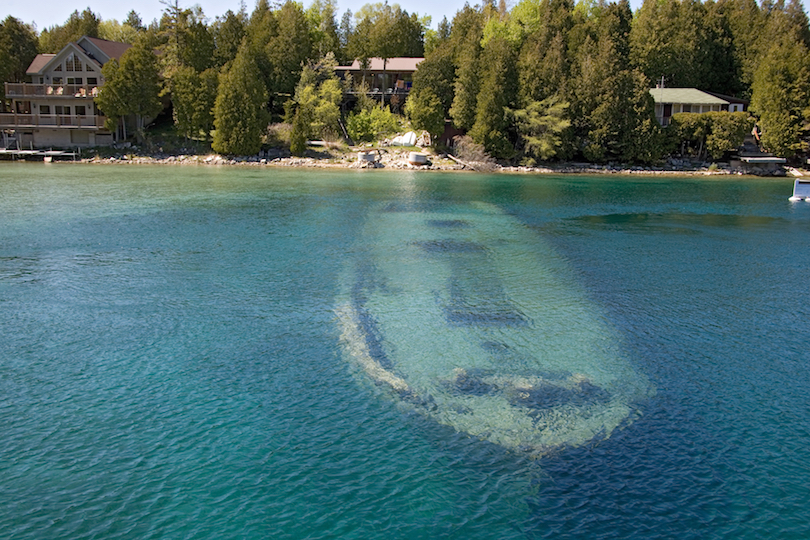 dreamstime/© Vladimir Kindrachov
dreamstime/© Vladimir Kindrachov
Named after another quite charming town in Scotland, this Tobermory is known as ‘the freshwater Scuba capital of the world’ – there are 22 shipwrecks to explore in the adjacent Fathom Five National Marine Park alone.
There are also many rock formations in Fathom Five – just off shore is Flowerpot Island, named for two flowerpot-shaped stacks on its coast, and which also features camping facilities and hiking trails. For the less adventurous there are glass-bottomed boat tours to glimpse the wrecks without getting wet.
Best Places to Visit in Canada
Today the town is known for its Gothic Victorian architecture, iconic for the Maritimes region Canada. It’s also famous for lobsters, with the largest lobster catch in Canada per year; you can sample this and more seafood at quirky seaside restaurant The Red Shed.
The idyllic mountain town Nelson first boomed thanks to the discovery of silver in 1886 at nearby Toad Mountain. Today many of the buildings that date from this era have been lovingly restored and make up much of what gives Nelson its old world charm.
It’s a cultural center packed with things to do in the form of restaurants, cafes, shops, art galleries, coffee houses, and more. Skiing and snowboarding are the winter activities; summer includes things like Marketfest, a lively nighttime market held on the last Friday of each month in June, July and August.
There are tours of the town on historic trolley buses, too. And after all that, a soak in some hot springs sounds lovely, doesn’t it?

Polar bears, beluga whales, and northern lights: Churchill has it all. Whilst Danish explorers reached this area in 1619, only 3 of the 64 expedition members made it back to Denmark – a more permanent history of Churchill begins in 1717, when the British Hudson’s Bay Company built the first settlement here. Relics of the Anglo-French dispute over North America still survive, such as the impressive 250-year-old Prince of Wales Fort.
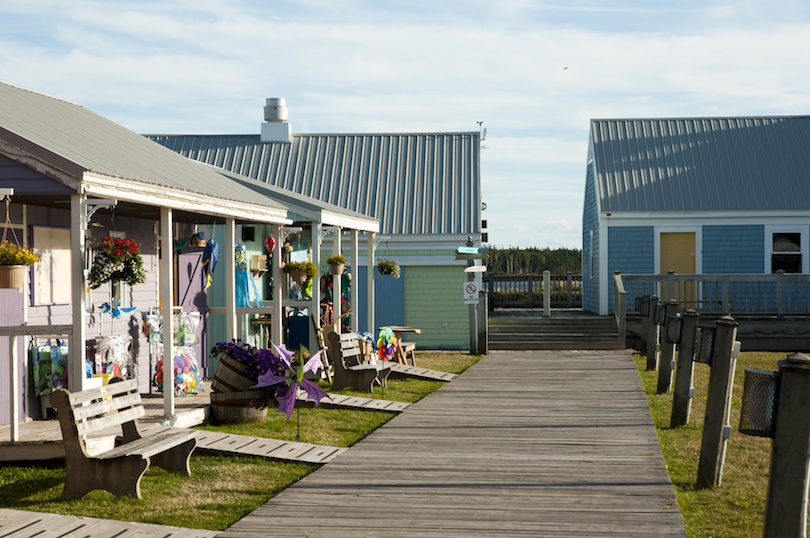 dreamstime/© Adwo
dreamstime/© Adwo
Incorporated as a town in 1877, Summerside seems to have the perfect name to reflect the nature of the town itself. Though relatively small, this is Prince Edward Island’s second largest ‘city’, and as such there’s a lot to do here. History lives and breathes in the tree-lined streets with their stately heritage homes, and learning about Summerside’s past is possible in the beautiful Wyatt Historic House Museum.
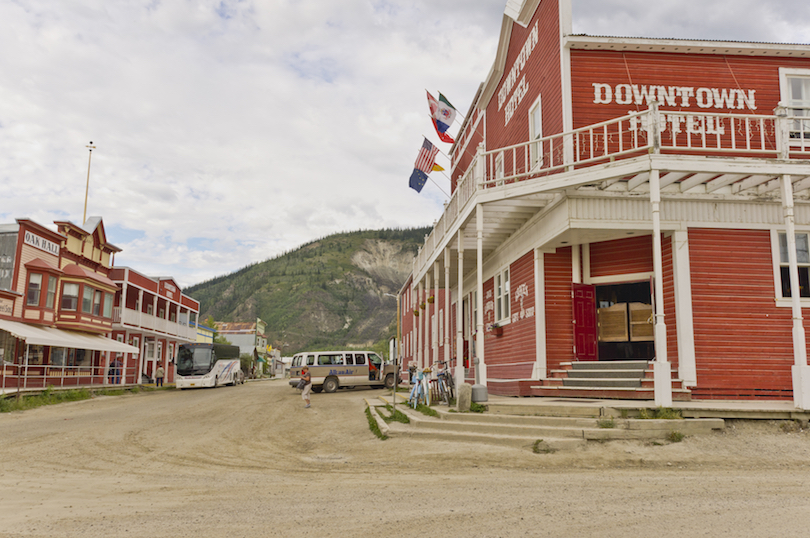 dreamstime/© Rlesyk
dreamstime/© Rlesyk
A real gold rush town, Dawson City was founded at a First Nations Camp in 1897 as a result of the Klondike Gold Rush, and quickly grew into a city of over 40,000 inhabitants, all eager for gold. Smaller now, historic Dawson City still brings in visitors.
The ‘Dawson Historical Complex’ refers to the quaint 19th century center of town; in fact, all new buildings have to comply with visual standards conforming to that 19th century look to keep it looking pretty. Weirdly it’s famous for the ‘Sourtoe Cocktail’ at the Downtown Hotel – complete with a real mummified human toe!
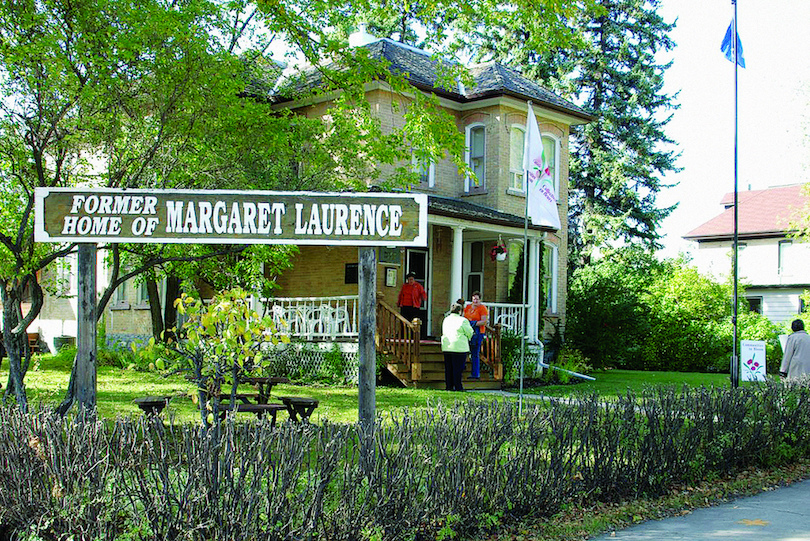 flickr/Travel Manitoba
flickr/Travel Manitoba
Known as ‘Manitoba’s Most Beautiful Town’, Neepawa was first settled in 1877. Like many places in Canada, the land was in use long before Europeans arrived – Neepawa meaning ‘Land of Plenty’ in the Cree language.
Today there are many historic buildings to admire: the Margaret Laurence Home, where the Canadian novelist grew up, and the iconic Roxy Theatre Neepawa, built in 1906, still in use today for events and current films. Curiously it is the self-appointed ‘Lily Capital of the World’ – 2,000 types of lily are grown in Neepawa, and sees 12,000 visitors each year to its July Lily Festival.
 wikipedia/Whpq
wikipedia/Whpq
Founded in 1828, and named after the British prime minister at the time, this town is proud of its aesthetics: its motto appears to be ‘Canada’s Prettiest Town’ – plus it has won awards in different categories of the Communities in Bloom competition.
It is claimed that Queen Elizabeth II called this the prettiest town in Canada (though there’s no record of any reigning monarch having visited). Historic attractions include the 1839 Huron Historic Gaol and the Huron County Museum, but outdoors-minded visitors will be more interested in the three beaches boasted by Goderich.
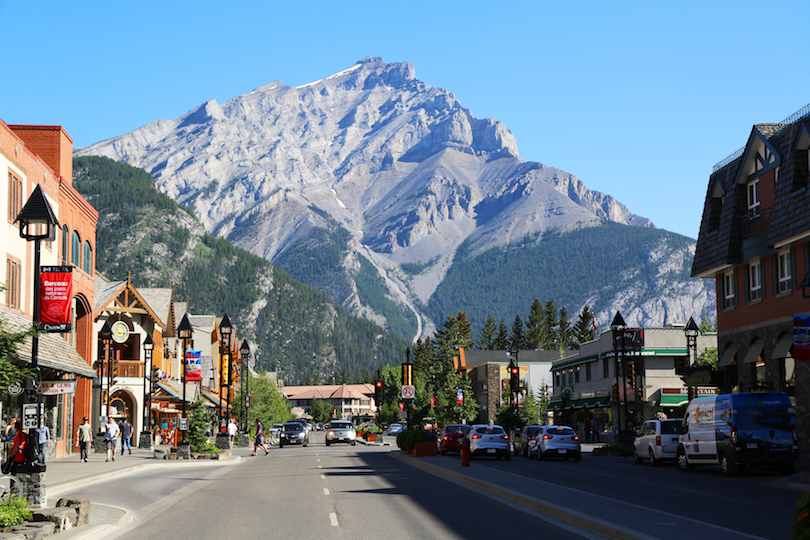 dreamstime/© Zhukovsky
dreamstime/© Zhukovsky
Tiny Banff grew up around the hot springs that were discovered here by railway workers in 1883. The Cave and Basin Hot Springs – now closed – are the first hot springs created here when the town was advertised internationally as a spa resort.
Today Banff is a busy and commercial town where you can pause for a couple of days to stock up on supplies before you explore Banff National Park. But never fear: you can still soak in mineral rich waters at Banff Upper Hot Springs, among others. Perhaps a good idea after a long hike at nearby Lake Minnewanka. The luxury 19th century Banff Springs Hotel is the place to stay, one of Canada’s famous grand railway hotels – more like a chateau than a hotel, it’s truly magnificent.
5. Brigus, Newfoundland and Labrador
This little fishing village dates back to around 1612, when first governor of Newfoundland Colony John Guy sold half the bay to the Spracklin family. Now it’s known for being particularly scenic, of course, as well as being full of interesting places. These include the 19th century Convent of Mercy, built for Irish nuns, St. George’s Anglican Church, and the Brigus Tunnel – hewn through solid rock to get to a deep-water harbor.
There’s also Hawthorne Lodge, the home of Arctic explorer Captain Robert Bartlett – one of a high proportion of Arctic explorers produced by this village.
There’s also the pristine All Saints Anglican Church. Many buildings feature vibrant, colorful murals. Aside from the architecture, whale watching is a big draw to this seaside town.
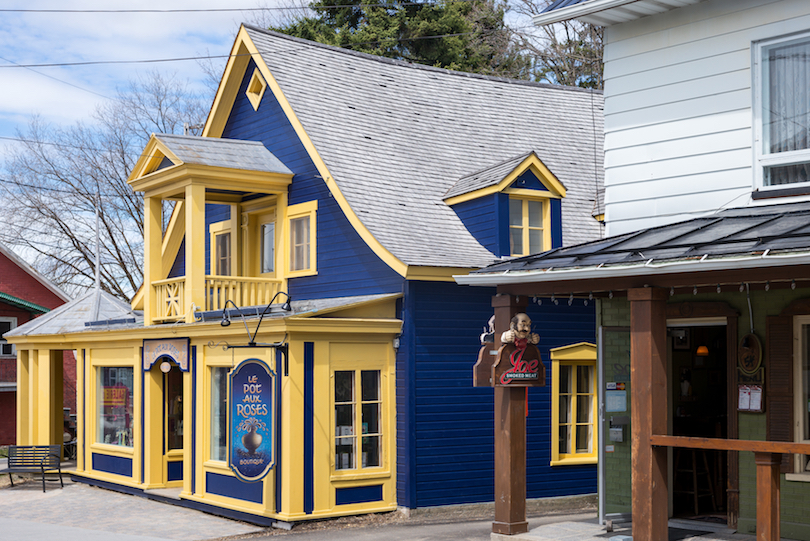 dreamstime/© Giuseppemasci
dreamstime/© Giuseppemasci
Believe it or not, one claim to fame that this Quebecois town has is that the Cirque du Soleil was founded here in 1984. Another less fun claim is the prominence Baie-Saint-Paul gained when Doctor Philippe-Louis-François Badelard named a disease he was studying after the town in the 1770s.
But apart from this, its narrow streets lined with boutiques and art galleries, plus historical landmarks like the 1714 Église de Saint-Pierre et Saint-Paul, make this a particularly pretty place to be.
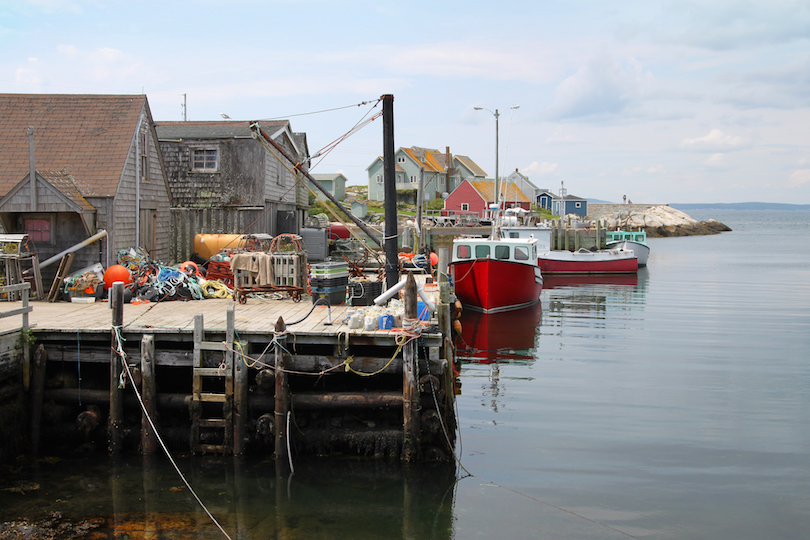 dreamstime/© Gvictoria
dreamstime/© Gvictoria
This tiny settlement on the Atlantic Coast has a long history of being a fishery, but since the end of World War II, Peggy’s Cove has been reliant more on tourism than catching fish. Today it is known for its picturesque coastal beauty.
Founded in 1811 when 6 families of German descent were granted permission to build here, the town is awash with quaint wooden fishing sheds that are characteristic of the town. Set amidst its sparse rocky coastline with the Atlantic stretching out from it as far as the eye can see, Peggy’s Cove is a postcard-perfect fishing village.
 dreamstime/© Steveheap
dreamstime/© Steveheap
Quaint colonial buildings; Niagara Falls – there’s a reason why Niagara-on-the-Lake is nicknamed ‘The Loveliest Town in Canada’. Known from the late 18th century as Butlersburg, then as West Niagara, it was a haven for pro-Loyalists fleeing the United States in the wake of the American Revolution.
Landmarks include the 1840s Old Court House Theater, and the oldest Catholic and Anglican churches in Ontario: St. Vincent de Paul (1826) and St. Mark’s Church (1791) respectively. From April to November the town puts on the Shaw Festival, a theatrical event featuring plays from George Bernard Shaw, among others.
From Francophone communities with strong connections to the first French settlers, to diverse British colonists, as well the country’s Aboriginal people, small towns in Canada are a mix of cultures and eras, where gold rush towns still look like gold rush towns, and grand railway hotels jut out of forests and also European castles. Here are some of the places that make exploring this expansive country a real joy.
15. Tobermory, Ontario
 dreamstime/© Vladimir Kindrachov
dreamstime/© Vladimir KindrachovNamed after another quite charming town in Scotland, this Tobermory is known as ‘the freshwater Scuba capital of the world’ – there are 22 shipwrecks to explore in the adjacent Fathom Five National Marine Park alone.
There are also many rock formations in Fathom Five – just off shore is Flowerpot Island, named for two flowerpot-shaped stacks on its coast, and which also features camping facilities and hiking trails. For the less adventurous there are glass-bottomed boat tours to glimpse the wrecks without getting wet.
14. Yarmouth, Nova Scotia
French Acadians first founded a settlement on the southwestern tip of the Nova Scotia peninsula in the mid 17th century, called Tebouque. Settlers from New England, however, arrived during the Seven Years War and named a nearby site after the town they came from in Massachusetts: Yarmouth.Best Places to Visit in Canada
Today the town is known for its Gothic Victorian architecture, iconic for the Maritimes region Canada. It’s also famous for lobsters, with the largest lobster catch in Canada per year; you can sample this and more seafood at quirky seaside restaurant The Red Shed.
13. Nelson, British Columbia
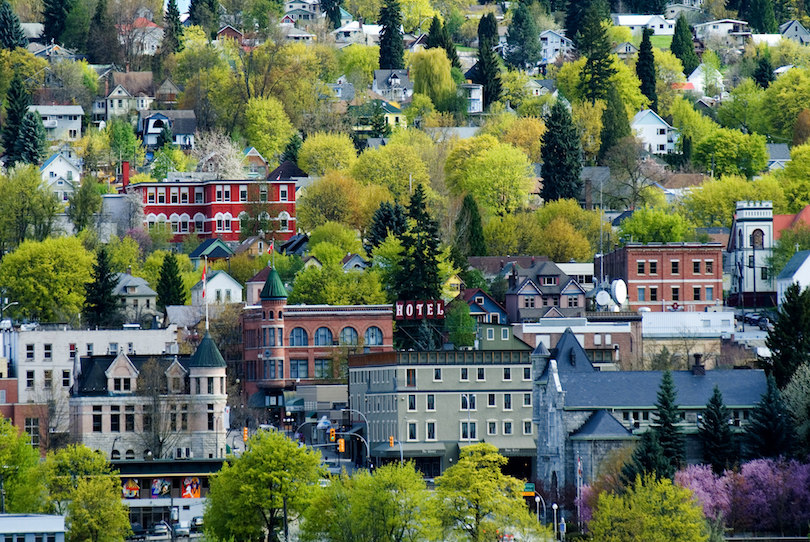 flickr/Province of British Columbia
flickr/Province of British Columbia
The idyllic mountain town Nelson first boomed thanks to the discovery of silver in 1886 at nearby Toad Mountain. Today many of the buildings that date from this era have been lovingly restored and make up much of what gives Nelson its old world charm.It’s a cultural center packed with things to do in the form of restaurants, cafes, shops, art galleries, coffee houses, and more. Skiing and snowboarding are the winter activities; summer includes things like Marketfest, a lively nighttime market held on the last Friday of each month in June, July and August.
12. Moose Jaw, Saskatchewan
Oddly named Moose Jaw is an attractive town with a number of historic buildings and things to do. There’s the Moose Jaw Tunnels, for instance, an underground network of tunnels connecting buildings made in 1908 for a steam system that never went ahead – Chinese immigrants hid here from persecution in the early 20th century, and Al Capone is rumored to have gambled and made deals in the subterranean spaces.There are tours of the town on historic trolley buses, too. And after all that, a soak in some hot springs sounds lovely, doesn’t it?
11. Churchill, Manitoba

Polar bears, beluga whales, and northern lights: Churchill has it all. Whilst Danish explorers reached this area in 1619, only 3 of the 64 expedition members made it back to Denmark – a more permanent history of Churchill begins in 1717, when the British Hudson’s Bay Company built the first settlement here. Relics of the Anglo-French dispute over North America still survive, such as the impressive 250-year-old Prince of Wales Fort.
10. Summerside, Prince Edward Island
 dreamstime/© Adwo
dreamstime/© AdwoIncorporated as a town in 1877, Summerside seems to have the perfect name to reflect the nature of the town itself. Though relatively small, this is Prince Edward Island’s second largest ‘city’, and as such there’s a lot to do here. History lives and breathes in the tree-lined streets with their stately heritage homes, and learning about Summerside’s past is possible in the beautiful Wyatt Historic House Museum.
9. Dawson City, Yukon
 dreamstime/© Rlesyk
dreamstime/© RlesykA real gold rush town, Dawson City was founded at a First Nations Camp in 1897 as a result of the Klondike Gold Rush, and quickly grew into a city of over 40,000 inhabitants, all eager for gold. Smaller now, historic Dawson City still brings in visitors.
The ‘Dawson Historical Complex’ refers to the quaint 19th century center of town; in fact, all new buildings have to comply with visual standards conforming to that 19th century look to keep it looking pretty. Weirdly it’s famous for the ‘Sourtoe Cocktail’ at the Downtown Hotel – complete with a real mummified human toe!
8. Neepawa, Manitoba
 flickr/Travel Manitoba
flickr/Travel ManitobaKnown as ‘Manitoba’s Most Beautiful Town’, Neepawa was first settled in 1877. Like many places in Canada, the land was in use long before Europeans arrived – Neepawa meaning ‘Land of Plenty’ in the Cree language.
Today there are many historic buildings to admire: the Margaret Laurence Home, where the Canadian novelist grew up, and the iconic Roxy Theatre Neepawa, built in 1906, still in use today for events and current films. Curiously it is the self-appointed ‘Lily Capital of the World’ – 2,000 types of lily are grown in Neepawa, and sees 12,000 visitors each year to its July Lily Festival.
7. Goderich, Ontario
 wikipedia/Whpq
wikipedia/WhpqFounded in 1828, and named after the British prime minister at the time, this town is proud of its aesthetics: its motto appears to be ‘Canada’s Prettiest Town’ – plus it has won awards in different categories of the Communities in Bloom competition.
It is claimed that Queen Elizabeth II called this the prettiest town in Canada (though there’s no record of any reigning monarch having visited). Historic attractions include the 1839 Huron Historic Gaol and the Huron County Museum, but outdoors-minded visitors will be more interested in the three beaches boasted by Goderich.
6. Banff, Alberta
 dreamstime/© Zhukovsky
dreamstime/© ZhukovskyTiny Banff grew up around the hot springs that were discovered here by railway workers in 1883. The Cave and Basin Hot Springs – now closed – are the first hot springs created here when the town was advertised internationally as a spa resort.
Today Banff is a busy and commercial town where you can pause for a couple of days to stock up on supplies before you explore Banff National Park. But never fear: you can still soak in mineral rich waters at Banff Upper Hot Springs, among others. Perhaps a good idea after a long hike at nearby Lake Minnewanka. The luxury 19th century Banff Springs Hotel is the place to stay, one of Canada’s famous grand railway hotels – more like a chateau than a hotel, it’s truly magnificent.
5. Brigus, Newfoundland and Labrador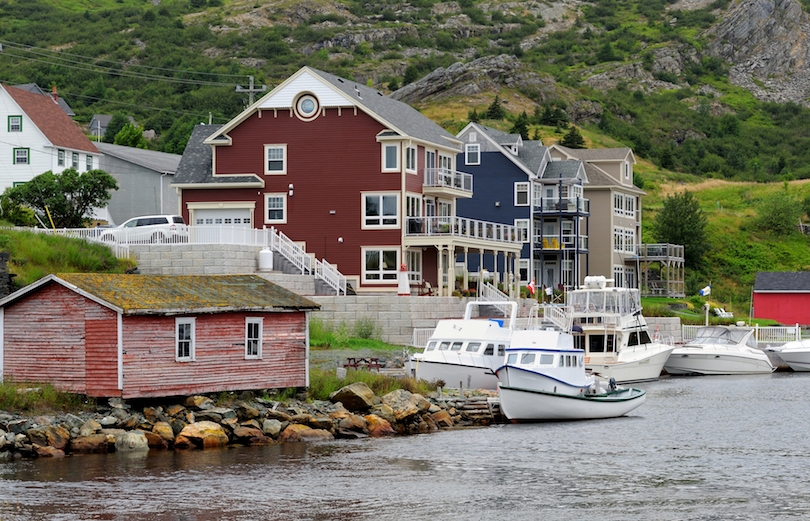 dreamstime/© Glenn Nagel
dreamstime/© Glenn Nagel
This little fishing village dates back to around 1612, when first governor of Newfoundland Colony John Guy sold half the bay to the Spracklin family. Now it’s known for being particularly scenic, of course, as well as being full of interesting places. These include the 19th century Convent of Mercy, built for Irish nuns, St. George’s Anglican Church, and the Brigus Tunnel – hewn through solid rock to get to a deep-water harbor.
There’s also Hawthorne Lodge, the home of Arctic explorer Captain Robert Bartlett – one of a high proportion of Arctic explorers produced by this village.
4. St Andrews By-the-Sea, New Brunswick
Officially Saint Andrews, this town received its ‘By-the-Sea’ nickname because, well, it’s by the sea! Founded in 1783 by United Empire Loyalists – those who fled during or after the American Revolution – the original parts of town remain well preserved. The Ross Memorial Museum, for instance, is a perfect example of a 19th century abode, filled with exquisite furniture.There’s also the pristine All Saints Anglican Church. Many buildings feature vibrant, colorful murals. Aside from the architecture, whale watching is a big draw to this seaside town.
3. Baie-Saint-Paul, Quebec
 dreamstime/© Giuseppemasci
dreamstime/© GiuseppemasciBelieve it or not, one claim to fame that this Quebecois town has is that the Cirque du Soleil was founded here in 1984. Another less fun claim is the prominence Baie-Saint-Paul gained when Doctor Philippe-Louis-François Badelard named a disease he was studying after the town in the 1770s.
But apart from this, its narrow streets lined with boutiques and art galleries, plus historical landmarks like the 1714 Église de Saint-Pierre et Saint-Paul, make this a particularly pretty place to be.
2. Peggy’s Cove, Nova Scotia
 dreamstime/© Gvictoria
dreamstime/© GvictoriaThis tiny settlement on the Atlantic Coast has a long history of being a fishery, but since the end of World War II, Peggy’s Cove has been reliant more on tourism than catching fish. Today it is known for its picturesque coastal beauty.
Founded in 1811 when 6 families of German descent were granted permission to build here, the town is awash with quaint wooden fishing sheds that are characteristic of the town. Set amidst its sparse rocky coastline with the Atlantic stretching out from it as far as the eye can see, Peggy’s Cove is a postcard-perfect fishing village.
1. Niagara-on-the-Lake, Ontario
 dreamstime/© Steveheap
dreamstime/© SteveheapQuaint colonial buildings; Niagara Falls – there’s a reason why Niagara-on-the-Lake is nicknamed ‘The Loveliest Town in Canada’. Known from the late 18th century as Butlersburg, then as West Niagara, it was a haven for pro-Loyalists fleeing the United States in the wake of the American Revolution.
Landmarks include the 1840s Old Court House Theater, and the oldest Catholic and Anglican churches in Ontario: St. Vincent de Paul (1826) and St. Mark’s Church (1791) respectively. From April to November the town puts on the Shaw Festival, a theatrical event featuring plays from George Bernard Shaw, among others.
